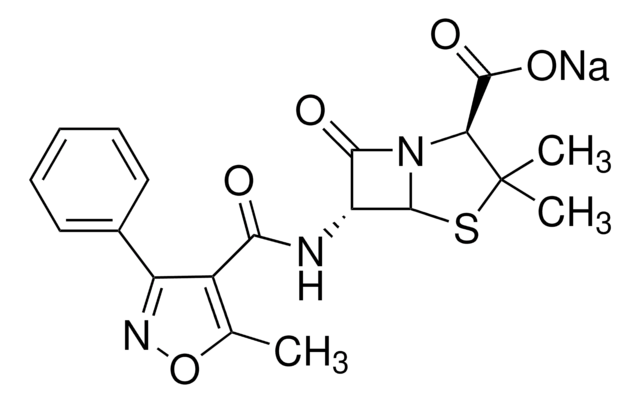P5280
Pyruvate de sodium
powder, BioReagent, suitable for cell culture, suitable for insect cell culture, ≥99%
Synonyme(s) :
αAcide α-cétopropionique sodium salt, Acide 2-oxopropanoïque sodium salt, Acide pyruvique sodium salt
About This Item
Produits recommandés
Gamme de produits
BioReagent
Niveau de qualité
Pureté
≥99%
Forme
powder
Technique(s)
cell culture | insect: suitable
cell culture | mammalian: suitable
Pf
>300 °C (lit.)
Solubilité
H2O: 100 mg/mL
Densité
1.78 at 20 °C
Application(s)
metabolomics
Température de stockage
2-8°C
Chaîne SMILES
[Na+].CC(=O)C([O-])=O
InChI
1S/C3H4O3.Na/c1-2(4)3(5)6;/h1H3,(H,5,6);/q;+1/p-1
Clé InChI
DAEPDZWVDSPTHF-UHFFFAOYSA-M
Vous recherchez des produits similaires ? Visite Guide de comparaison des produits
Catégories apparentées
Description générale
Application
- to culture MCF7 ρ0 (human breast cancer cell line) cells as parent cells
- as a supplement in extracellular flux (XF) assay media to incubate cells for measuring oxygen consumption rate (OCR)
- as a supplement in minimum essential medium Eagle to maintain breast cancer (MCF-7) cells
- as a supplement in Dulbecco′s modified Eagle medium (DMEM)-based medium and modified Eagle medium (MEM)-α for testis cell culture to evaluate the effect of medium composition on in vitro SSC maintenance
Actions biochimiques/physiologiques
Caractéristiques et avantages
- Cell culture and insect cell culture tested
- Versatile and adaptable for a wide variety of laboratory and research applications
- BioReagent Grade Sodium succinate for your Cell Biology and Biochemical research
- Tested for Mammalian and Insect cell culture applications
Autres remarques
Produit comparable
Produit(s) apparenté(s)
Mention d'avertissement
Warning
Mentions de danger
Conseils de prudence
Classification des risques
Eye Irrit. 2 - Skin Sens. 1B
Code de la classe de stockage
13 - Non Combustible Solids
Classe de danger pour l'eau (WGK)
WGK 1
Point d'éclair (°F)
Not applicable
Point d'éclair (°C)
Not applicable
Équipement de protection individuelle
Eyeshields, Gloves, type N95 (US)
Certificats d'analyse (COA)
Recherchez un Certificats d'analyse (COA) en saisissant le numéro de lot du produit. Les numéros de lot figurent sur l'étiquette du produit après les mots "Lot" ou "Batch".
Déjà en possession de ce produit ?
Retrouvez la documentation relative aux produits que vous avez récemment achetés dans la Bibliothèque de documents.
Les clients ont également consulté
Articles
We presents an article about the Warburg effect, and how it is the enhanced conversion of glucose to lactate observed in tumor cells, even in the presence of normal levels of oxygen. Otto Heinrich Warburg demonstrated in 1924 that cancer cells show an increased dependence on glycolysis to meet their energy needs, regardless of whether they were well-oxygenated or not.
Information on fatty acid synthesis and metabolism in cancer cells. Learn how proliferatively active cells require fatty acids for functions such as membrane generation, protein modification, and bioenergetic requirements. These fatty acids are derived either from dietary sources or are synthesized by the cell.
Notre équipe de scientifiques dispose d'une expérience dans tous les secteurs de la recherche, notamment en sciences de la vie, science des matériaux, synthèse chimique, chromatographie, analyse et dans de nombreux autres domaines..
Contacter notre Service technique





